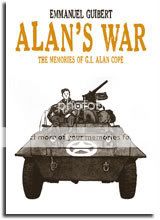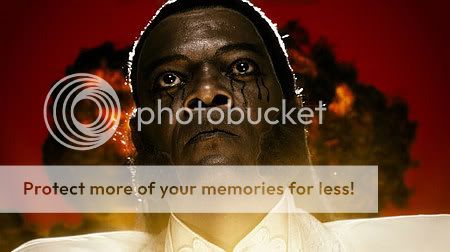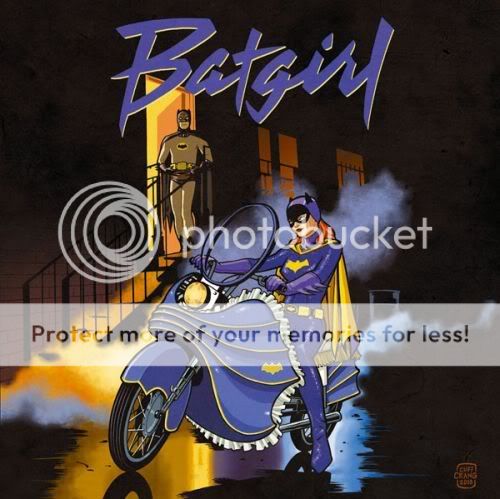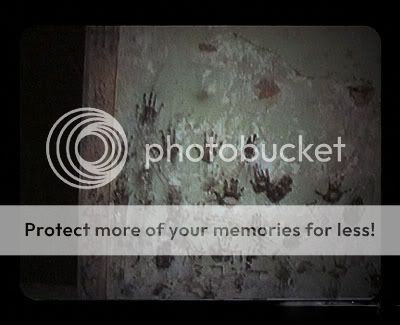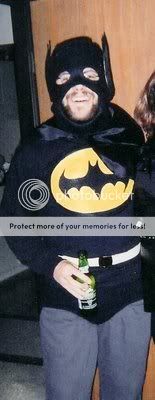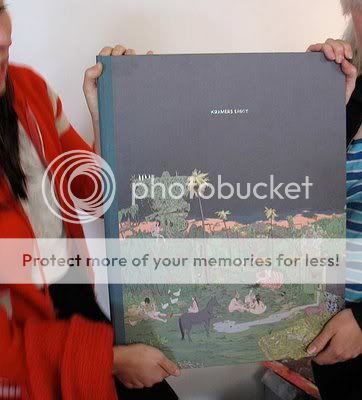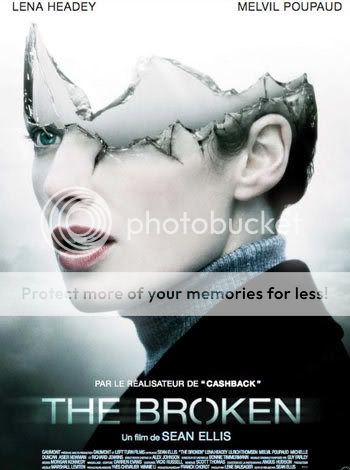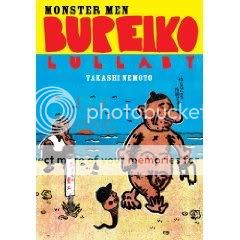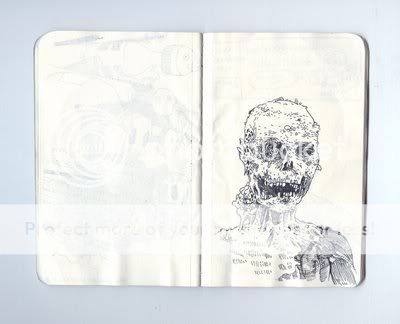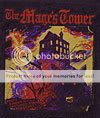Author Archive
Comics Time: Bone
November 7, 2008Bone
Jeff Smith, writer/artist
Cartoon Books, 2004
1,344 pages!!!
$39.95
Rarely have I gone less far out on a limb than by calling Jeff Smith’s “cartoon epic” Bone universally beloved. One need look no further than the acknowledgments page, which offers sincere thanks to supportive comics-industry players ranging from Marv Wolfman to Art Spiegelman, Harlan Ellison to Craig Thompson, Wizard to The Comics Journal. Frankly it’s not tough to see why everyone’s wild about the thing. A lushly drawn and ostentatiously cartooned fantasy epic starring funny animals self-published over the course of 12 years? There’s really something for everybody in there.
Let’s start with the part that wasn’t for me: The cutesy comic business left me flat for the entirety of the saga. Simply put, this book didn’t make me laugh out loud a single time, and given how much of it is dedicated to supposed-to-be-funny schtick involving the titular Bone cousins, rustic villagers, cowardly rat creatures and so on–especially in the early going–I think that’s a real problem. To be honest, if this wasn’t BONE, if I hadn’t been hearing about it for as long as I’ve read comics, I wouldn’t have gone much further than the opening chapter or two. I think there was one gag that kinda made me snort, but now I have no idea what that was, which is revealing in its own way. (It certainly wasn’t the recurring bit about quiche.)
Obviously, what draws you in and keeps you involved even when the “Tolkien as Saturday morning cartoon on Nick Jr.” humor drags on is Smith’s cartooning. I know I tend to tout character design a lot on this blog, but the effortlessly classic looks Smith comes up with for his major players are almost in a class by themselves. I’m not saying they’re necessarily all brilliant or innovative–there’s a certain slick Disneyness to a lot of it–but in a way that’s the selling point right there: These characters and creatures look like you’ve been seeing them all your life. The droopy-eyed, floppy-eared Great Red Dragon; Mammy Yokum-esque Gran’ma Ben; giant, dead-eyed, rictus-grinned Kingdok (he’s like a huge furry Jaws!) and his rat-creature minions; the eerily faceless Hooded One and the solemnly robed stick-eaters; gorgeous, shaggy-haired Thorn, especially early on; and the part-Pogo, part-Snoopy, part-Smurf, all-Bone Fone, Phoney, and Smiley…that’s a helluva batting average. Having characters that unimpeachably solid running around makes the narrative all the more seductive–a must when you’re dealing with something this long and sprawling.
But you know, sprawling might not be the right word. It is a massive, massive story, and God only knows what it felt like to read it parceled out in individual issues over the course of a decade rather than in single volume that’s heavier than my laptop computer. Even still, each chapter moves rather smoothly and inexorably into the next, like a prose fantasy epic would. This is a very different reading experience than a 1300-page collection of even the most cohesive superhero-comic run, where individual stand-alone issues and even storyarcs would diverge from the main narrative. And again, I think this linearity is a necessity for what Smith is trying to accomplish. Over the course of the story there is a pretty massive tonal drift, but looking back, I couldn’t pinpoint precisely when it happened; all of a sudden you look around and the line is thinner and harsher, the pages look speckled with dust and debris versus the clean black and white of earlier chapters, and the story has gone from cow-racing and meet-cutes to internecine warfare between religious orders and attempts to thwart the beast of the apocalypse. This is accomplished with such a lack of herky-jerky shifts and seams that you hardly even notice it happening until it’s already happened.
Does Smith fall back on standard fantasy archetypes and narrative tropes to do some of this work for him? Of course. The whole set-up–cute, diminutive, innately noble little guy and his cousins do the fish-out-of-water thing to save the tunic-wearing folk and secret, hidden royalty of a fallen kingdom against a resurgent and vengeful dark lord–is lifted directly from The Lord of the Rings. And as the common complaint against that work goes (a complaint I’ve never shared, but then I have the White Tree of Gondor tattooed on my arm, so I probably wouldn’t), Bone‘s early, comparatively inconsequential chapters feel drawn out while the conclusion seems rushed. As I said, lingering on the unfunny comic business of the hapless Bones learning the rules of the road in the fantasyland they’ve stumbled across is a real obstacle to enjoying the book; by the end that stuff is mostly gone and replaced with what is to me a much more fun fantasy war/adventure story, but not even a geek like me is blind to how many key plot points there at the end are revealed through dreams and visions rather than earned, for want of a better word, and how rapidly key enemies and obstacles are overcome.
Unsurprisingly, Smith’s fantastical worldbuilding and storytelling shine brightest at their most idiosyncratic, from both a narrative and artistic standpoint. We’ve all seen hooded, faceless villains before–again, see Tolkien–but when Smith’s Hooded One speaks, the word balloons seem to ooze directly from the cavernous folds of the hood. I wasn’t 100% sold on doing cartoony dragons instead of dragons who are actually scary and intimidating, but then you get a look at the whole dragon bestiary, and seeing every possible variation of cartoony dragon gives the concept a dizzying, zany punch. The creation myth and cultural hierarchy Smith devises are personal enough to somewhat transcend the elements they share with countless other such mythoi. I’m still trying to figure out why the giant mountain lion Rockjaw comes to dominate the middle third of the book and then reappears later to do…nothing; he’s like the book’s somewhat sinister version of Tom Bombadil. And there’s one really chilling, batshit crazy sequence where the theocratic tyrant ruling over the abandoned kingdom confronts the Hooded One, only to be completely one-upped and outclassed in the insane and hideous and violent departments–that one will stick with me for a long time. The final fate of the big adversary was also quite memorably done–I saw the basic contours of that confrontation coming, but their final shape was not one I predicted at all.
I found reading Bone in a short timespan over these years to be a pretty engrossing experience, all told. Particularly toward the end, I’d anxiously look forward to my next train ride or pre-bedtime read to find out what happens next. But it never knocked my socks off, which seems to be what this kind of story is meant to do. I’m glad I read it, but had I never done so I think my life would have gone on just fine. There’s no tattoo of the Crown of Horns in my future.
Carnival of souls
November 6, 2008* Here is the trailer for the next Clive Barker-based movie, Book of Blood. The Radiohead remix adds hella production value, I think. Also, how nice is it to see a Barker adaptation retain the original English setting and accents?
* And here’s a promo reel for the next Barker flick, Dread–featuring interview snippets from Barker, director Anthony DiBlasi, and the cast, as well as boobies and some pretty horrifying things involving bleach.
* Meanwhile, I still haven’t seen Midnight Meat Train–I didn’t have it in me to try to OnDemand it the night before the election as originally planned. I know reviews from those I trust have been lukewarm, but Christ, if ever there was a movie I need to see for myself! Meanwhile, just so I can keep it straight in my head, I think the two Films of Blood on the way after Dread are The Madonna and Pig Blood Blues. Even if all of these films turn out kind of dull, I’d rather the horror section at Best Buy be filled with dull churned-out shingle-based horror movies based on great Clive Barker short stories that theoretically could find a new audience through them than dull churned-out shingle-based horror movies based on nothing in particular.
* Looks like George A. Romero’s next …of the Dead flick is, in fact, going to be called …of the Dead. I can get behind that. Please be good.
* I really admire the obvious amount of thought and heart that went into Shaun of the Dead star Simon Pegg’s Guardian-published essay about why zombies should be slow, but I also find it really silly (albeit admittedly so) when it tries to support that assertion on the grounds that fast zombies aren’t “realistic,” and really wrongheaded when it claims that speeding up zombies strips them of metaphorical power. Eve Tushnet, Bruce Baugh, and I beat up on that idea pretty good in a comment thread a while back. (Via Jason Adams.)
* Speaking of Bruce, here he runs down World of Warcraft’s creation myth. Actually, that’s an inaccurate word to describe it because in the game world, these things factually, demonstrably happened–there are Old God corpses lying around to prove it and everything. Anyway, it’s an intriguing, “art of enthusiasm”-style mix of Lovecraft, Greek mythology, and Tolkien.
* If I had to rattle off the names of, I dunno, the 10 people most directly responsible for my life being what it is right now in terms of the prominent role comics play in it, Joe Quesada and Bill Jemas would be on there thanks to their construction of so-called “Nu-Marvel” in the early ’00s. Therefore I’m really enjoying their reunion interview with Jonah Weiland at CBR. Jemas in particular is an interesting case: His ideas and approach really did shake up the company and make superhero comics much, much better on a qualitative level, but then as best as anyone can tell he kind of went a little ego crazy, and he was relatively quickly shuffled aside by his superiors. I think there are similar executive trajectories one can point to that were not brought to an end nearly as early, with the results you’d expect.
* This interview with Dan DiDio offers the first hints of an official confirmation that the art changes and scheduling delays for Final Crisis are due at least in part to tardy scripts from Grant Morrison. God knows I love the Mad Scotsman, but his work does tend to run into these kinds of problems, and the common denominator is, well, him. I’m not even complaining about the lateness (the calvacade of artists, now that I have some beef with from time to time)–it just has long seemed a shame to me that it all got laid at the feet of either the artists or the editors or the executives.
* I’m also excited to read that my friend and former boss Brian Cunningham will be involved via his new editorial capacity at DC in the upcoming Green Lantern (and i think overall DCU) event Blackest Night. If you look back at the past couple of years at DC, a lot of attention was given to Countdown and its countless spinoffs and tie-ins, none of which really merited it; but at the same time, you’ve seen pretty tremendous and momentous work on Green Lantern, Superman, and Batman from Geoff Johns and Grant Morrison. If, after 52, DC had done everything exactly the same–published Countdown, Countdown to Adventure, Countdown to Mystery, Countdown Presents the Search for Ray Palmer, Countdown: Arena, Salvation Run, Amazons Attack et al–but just made the mental and promotional adjustment of declaring Johns’ and Morrison’s main titles and events–Batman, Green Lantern, Action Comics, The Sinestro Corps War, The Resurrection of Ra’s al Ghul–the so-called “spine” of DC’s superhero line instead, I think you’d have a very different landscape to look at right now. Anyway, I think these missteps have badly undercut Final Crisis in terms of fan reception, but clearly the emphasis placed on it and Batman R.I.P. and Superman: New Krypton and Flash: Rebirth and Blackest Night indicate that DC is now aware of where its bread is buttered.
* They’re gonna make a movie out of Paul Pope’s yet-to-be-published cyclopean fight scene graphic novel Battling Boy.
* What can one say about being married to a woman whose first thought upon the election of the new president is “this reminds me of ‘The Battle of Evermore'”?
Mister Miracle
November 5, 2008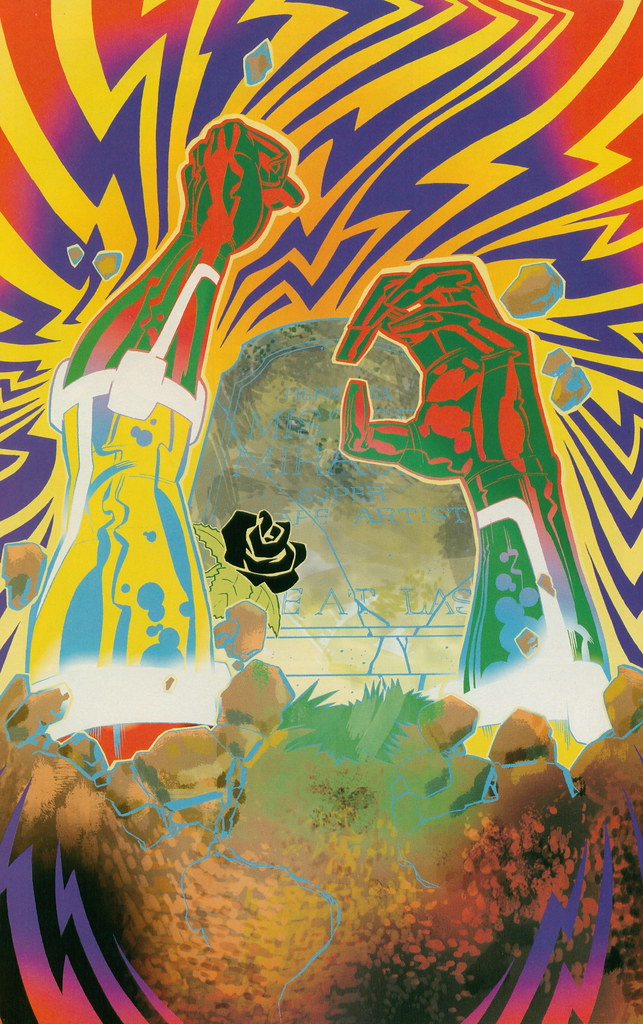
Comics Time: Alan’s War
November 5, 2008Alan’s War
Emmanuel Guibert, writer/artist
First Second, November 2008
336 pages
$24
You immediately judge Alan’s War against two separate non-fiction genres: World War II books and graphic memoirs set against major historical backdrops. You’ll find it a low-key affair when stacked up against either. Culled from “The Memories of G.I. Alan Cope,” as Guibert’s subtitle puts it, Alan’s War is as different from, say, Ken Burns’s The War as the possessive proper noun is from the definite article. As a matter of fact, Alan is barely in the war; the vast majority of his recollections are of times before or after his entry into hostilities, such as it was. To hear Alan tell it, he appears to have been involved in combat only one time and never saw his attackers. The most horrific incidents he recounts both took place during Germany’s surrender. It’s not D-Day or Iwo Jima by a long shot. Nor is it Maus, where Vladek’s experiences spoke directly to the central horror of the war. Nor even is it Persepolis, where Marjane’s forceful personality made the conflict with Revolutionary Iran feel a lot more direct than events actually bore out. Instead it feels a lot more like Siberia, a sort of meandering, matter-of-fact presentation of a gentle soul who couldn’t help but butt up against a cataclysmic world-historical scenario. In Siberia’s case the inhumanity of the totalitarian USSR was really just another challenge for Nikolai Maslov’s depressive personality; in Alan’s War, life in the Army simply pushes Alan in a different direction but still is primarily viewed through the lens of the friendships it enables him to form. We come to see that interpersonal relationships are the way Alan learns about himself throughout his long life, culminating in a spiritual and philosophical “rebirth” late in his life owed to acquaintances he made in occupied Germany. This particular narrative throughline is obviously constructed by Guibert’s editing of Alan’s story, which begs perhaps the most interesting unanswered question in the book, that of Alan’s possible homosexuality. The frequency with which Cope’s reminiscences star friends and fellow soldiers coming to terms with their own identity led me to wonder whether that was the one act of self-examination the kindly intellectual was never quite able to perform on himself. In its way Alan’s War is an compelling little book, its idiosyncratic protagonist going a long way to humanize art that is occasionally static and obviously photoreffed in the way that those rotoscoped credit card/financial adviser/whatever they are commercials that subtract a bunch of lines from a person’s photo can look, but is just as frequently endearing in its simplicity.
11.04.08, 11pm EST
November 4, 2008My favorite song from my favorite album of the trip-hop era is a tribute to Barry White, which I didn’t realize for a long, long time. The point of it is the liberation of dancing, and after a long build-up of groove and falsetto vocals, the keyboards finally kick in, and it’s glorious, and this is what it feels like.
Oh Barry, you should have danced with me
All night long, yeah
All night long
‘Cause you’ve got so much to give
“Help me, Obi-Wolf Kenoblitzer—you’re my only hope.”
November 4, 2008Carnival of souls
November 4, 2008* The moment I have been waiting for has arrived! I’m talking, of course, about Bruce Baugh discussing the mythology of World of Warcraft. What did you think I meant? Bruce’s initial post on the topic praises the game’s writers for creating a fantasy world that’s both sprawling and, in some ways, actually post-apocalyptic.
* One thing Bruce touches on that I myself picked up on right away is the presence of more than two opposing forces. When I was a kid, I was always drawn to characters who, though evil, constituted a “third way” that was distinct from both the good guys and the main bad guys: Destro in G.I. Joe, Hordak and those snake guys in He-Man, the Rat King in Teenage Mutant Ninja Turtles, Jabba the Hutt, Boba Fett, and the bounty hunters in Star Wars, Shelob, Old Man Willow, and the Balrog in Tolkien, and so on. In essence, WoW boasts several such factions, which align and realign in such a way as to force alliances and conflicts out of a variety of configurations of the opposing powers. Now, in some ways that’s just common sense–the real world is not a bipolar one, and even during roughly bipolar periods like World War II or the Cold War you had any number of independent actors out for themselves. (Stalinist Russia during the former and Maoist China during the latter are really the Destros of 20th-century geopolitics.) But in the context of a fantasy world I’m viewing through the eyes of my inner eight-year-old, realism has nothing to do with it–it’s sheer magic.
* In a second, somewhat related post, Bruce takes a look at a major facet of the game as it stands these days–massive, organized attacks on the other races by a legion of demonically spawned undead called the Scourge–in terms of how it’s manifested as gameplay. The mechanics of the Scourge’s invasion are unique and greatly enjoyable–giant floating necropolises!–but in terms of my love of third-way villains, I could be wrong but I think this is a case of the game’s third-way villains becoming the main antagonist, like if in the ruins of the Empire some surviving minion of Jabba the Hutt got ahold of another Death Star and some cloning facilities and went buckwild. I love it!
* Moving on, I’m sorry but I can’t see any reason I shouldn’t be predisposed to liking a movie in which you can see this:
* There used to be a piece on Splash Page in which Grant Morrison reveals that he’s been involved in some way with preparations for a Flash movie, but I think it’s gone now? Anyway here’s what he said:
“The thing with Hollywood stuff,” Morrison started to explain, “is that I’ve signed all these NDAs, so I can’t talk about it. I don’t want to get myself in trouble for saying the wrong things. There’s a lot of projects I’m not ready to talk about. I can’t. It’s just not allowed.”
So we thought we were shifting gears by asking him his thoughts on the upcoming “Flash” film — after all, he’s resurrected the Flash in “Final Crisis.” But it appears that we may have hit upon another sore spot, since it appears he’s pitched a “Flash” film.
“Yeah, that’s the kind of thing I can’t talk about,” Morrison said. “Yes, I have talked to them. I’m deeply involved in those discussions. I know what’s going down with all of that, and it’s actually really exciting. But beyond that, I can’t say anything. I wish I could tell you. I’m sure announcements will probably be made at some point, but I can’t say anything.”
* Non-indie-comics reader Ben Morse ponders Matt Kindt’s Super Spy.
(Via Kennyb.)
Orbital – Belfast
November 3, 2008Over the past week or so this has become my default song. Walking to the train in the morning, walking to the train in the evening, riding the train, writing, reading, working. A few nights this past week I’ve put it on my headphones just before bed and just lied on my back, listening, letting sleep creep over me. Short of being under the influence it’s the closest I’ve come to experiencing the song as a physical thing–the bass hitting me like a soft gust of air, each tinkling high note gently tapping its way across my head. And like most of Orbital’s best tracks it will switch gears and lock into a new thing every so often–that insistent piano triplet, the moment when everything but the rhythm drops out and you’re left skating across the black before the colors creep back in.
Carnival of souls
November 3, 2008* OMFG KATE WINSLET
(Via Jason Adams.)
* Another massive, massive interview with Clive Barker has been posted at his official (and sadly RSS-less) site Revelations. Topics include the fourth and fifth Abarat books, the film adaptations of Midnight Meat Train, Dread, and The Book of Blood, and a lengthy stroll through Barker’s prodigious notes on various and sundry other projects past, present, and future. Two-dicked demons are mentioned, as is so often the way of such interviews. (Via Dread Central.)
* Lots of news on George A. Romero’s next Dead film: USA Today quotes Romero as saying that the film will be about a factional schism between people who want to kill the zombies and people who hope they can be cured. Dread Central clarifies a point made in the USAT article regarding the return of characters from Land and Diary, saying that while some actors will return, there will be no characters from the former and only arguably one from the latter. Fangoria doubles down on the “character from Diary returns” angle as confirmed by executive producer Peter Grunwald, and characterizes the film as the story of a Hatfield/McCoy-type rivalry inspired by the William Wyler Western The Big Country. I just hope it’s not a terrible, terrible movie like Diary was.
* I don’t do industry commentary that much anymore, but the other day Tom Spurgeon posted a long piece on the possible ramifications of the recession on comics, and I submitted a brief reaction to it.
* Also at Tom’s you’ll find my response to his latest Five for Friday reader-participation feature, about scary comics moments. You’ll really want to click over to this one–the responses, and the illustrations, are pretty unnerving.
* The story of how Terrence Howard lost his job as War Machine in the Iron Man sequel is actually kind of funny–apparently he was a bit of a dick on set of the first flick, but more amusingly he was paid more than Robert Downey Jr., Jeff Bridges, or Gwyneth Paltrow because he was the first person Marvel Studios signed and in retrospect they realized they fucked up.
* Jeph Loeb is the worst of the eight to twelve contemporary superhero comics writers who can sell a project on their name alone. Apparently he didn’t do such a hot job on TV either, because he’s been fired from Heroes.
* My pal Ben Morse tells the tale of a Wizard feature we never got off the ground–the mother of all “who would win in a fight?” features, limited to hand-to-hand specialists. It woulda been sweet.
* “Barbara?” “Yes, Bruce.” “Is the water warm enough?” “Yes, Bruce.” “Shall we begin?” “Yes, Bruce.” (Via Kevin Melrose.)
* Finally, please do your part to end the bottomless horror of America’s torture regime, a horror I foolishly and disgracefully supported, by voting for Barack Obama tomorrow.
Comics Time: Siberia
November 3, 2008Siberia
Nikolai Maslov, writer/artist
Soft Skull Press, 2006
98 pages
$19.95
Originally written on November 1, 2006 for publication in The Comics Journal
Martin Scorsese’s Casino ends with narrator Sam “Ace” Rothstein declaring of the story he’s just told, “And that’s that.” There’s nothing that straightforward and simple about the movie itself, which is an absolute masterpiece of excess; but as an imaginary capstone to Nikolai Maslov’s memoir of Communist life Siberia, it works perfectly. From Maslov’s barely-there pencils-only art to his story’s episodic “and then this happened, and then this happened, and then this happened” structure, everything about this graphic novel evokes the feeling that Maslov is telling his tale not to find meaning within it, but to ascribe meaning to it – as if the simple act of recounting a life of grinding poverty, ubiquitous alcoholism, mental illness, and utter hopelessness will lend it a purpose that the Soviet structure relentlessly denied it. Maslov’s figure work and portraiture are startlingly effective; they never rise too far above the level of “very talented high-schooler,” but the pathetic ugliness of nearly all of his characters, including himself – they all look mildly retarded – is an almost perfect mechanism for chronicling a life and a society gone sour. The intimacy of the art’s soft gray makes some of the sourest moments, like the scene in which an alcoholic peasant literally laps spilled wine up off the ground, an almost unbearable intimacy. Siberia lacks the sort of narrative through-line that characterizes most memoir writing, which can be both a curse and a blessing. Like a Harvey Pekar of Stalinism, Maslov doesn’t always convince us that these anecdotes are worth relaying. But there’s an undeniable frisson to be found in the fact that he and the rest of Russian society escaped from the grip of authoritarianism – if, as is now apparent, only for a little while – to relay them at all. That seems to be Maslov’s message, to the extent that he has one beyond trying to come to terms with his own life. And that’s that.
Tim Curry – I Do the Rock
November 1, 2008Somewhere between plastic-soul David Bowie, “Sweet Transvestite,” and “Werewolves of London.” The veneer of 1970s cocaine-sprinkled* sophistication provided by the name-dropping lyrics and indeterminate-origin Eurotrash accent is really something to behold. I would be totally fine if Curry had entirely dropped acting for a music career, and I like his acting!
* “Sprinkled” may be lowballing it a bit.
Carnival of souls: special “keep the Anti-Christ in Halloween” edition
October 31, 2008* I think my favorite of all the bloggy Halloween festivities I’ve spotted today can be found at Jason Adams’s My New Plaid Pants, where he’s basically wallpapering the site with context-free horror:
* My pal “Beardy Kiel” Phegley’s trip down Halloween-costume memory lane was pretty neat too.
* So was Not Coming to a Theater Near You’s tribute to the best and worst covers, titles, and taglines from their monthlong look at VHS horror. Be sure to move your cursor over the box art!
* Midnight Meat Train is now available OnDemand! Something tells me this isn’t the Missus’s idea of Friday night viewing, but maybe I’ll be able to report back on Monday evening.
* I can’t decide what to go with here: “That’s no anthology–that’s a space station”? “Look on my works, ye mighty, and despair”? “My God, it’s full of stars”?
* I thought CRwM was making a provocative, if ultimately unpersuasive, argument that horror critics need to see the Saw movies to be worth taking seriously and I responded to it as such, but apparently it was a joke? Dang.
* Plenty of interesting books to discover in Eric Reynolds’s belated SPX report.
* This font is getting a little overused on horror promos at this point, but I thought the poster for The Broken was quite striking, and not just because it’s of the gorgeous Lena Headey (well, part of her at least):
* Eerie work from Renee French. I know, shocking, right?
* This reel of sneak-attack murders from the video game Manhunt goes from disturbing to hilarious to appalling to even more hilarious and back again three or four times during the course of the clip. I wish the blood spurts were more realistic. (Via Joystick Division.)
Imogen Heap – “Just for Now” (live)
October 31, 2008It’s that time of year
Leave all our hopelessnesses aside (if just for a little while)
Tears stop right here
I know we’ve all had a bumpy ride (I’m secretly on your side)
Happy Halloween
October 31, 2008Comics Time: Monster Men Bureiko Lullaby
October 31, 2008Monster Men Bureiko Lullaby
Takashi Nemoto, writer/artist
PictureBox Inc, September 2008
200 pages
$19.95
What even to say about Monster Men Bureiko Lullaby? It’s the kind of book that sets up a “get it/don’t get it” dichotomy almost automatically. There’s very little in terms of traditional parameters against which you can weigh the endless parade of transgression and revulsion, the shit-eating and child rape, the cancer and mutilation, the squiggly, cluttered line and resolutely ugly characters and environments. Unlike Johnny Ryan’s work, it doesn’t use the gross-out constituent parts to build up jokes–and I’m not just talking Ryan’s more straightforward gag strips and funny stories, I mean it doesn’t even go in for the super-labrynthine, Pythonesque digression structure of some of Ryan’s recent-ish stuff–nor, of course, does it share Ryan’s lovely, classically influenced line. Unlike the work of Rory Hayes, it doesn’t convey that sense that you’re seeing someone’s searing, indelible, personal artistic vision–there’s no unique vocabulary of teddy bears and demons, no electrocuted lines that look like they radiated directly out of the artist’s brain.
Perhaps appropriately, what it most feels like to me is someone excreting their id all over the pages, paying virtually no attention to anything other than simply pooping out every horrible thought in his head. It’s like…if someone who was already kind of gross had their self-censoring mechanism surgically removed, and then did a week’s worth of 24-hour comics in a row. The initial suite of short stories–starring a man whose penis takes over his body, flipping it over so that the guy walks on his hands as his dick and balls take on the shape and skills of a face; an idiot-savant artist whose only subject is his penis, which he cuts off and sends to a girl he sees peeing as an attempt to mitigate her tragic penislessness; and “the world’s most mature baby,” who begins fucking his own mother while still in the womb–are somewhat disjointed in effect, eschewing storytelling rhythm for a pile-up of excess. The book’s epic centerpiece, the two-part “The World According to Takeo,” really is more in the vein of an improvised 24-hour comic–in an interview with PictureBox’s Dan Nadel included in the volume, Nemoto says he started the comic with a few simple themes and no idea of how it was going to proceed or end in mind. It meanders, escalates, and by its second part coheres into something more sophisticated than the rest of the material here: The presence of readily understandable themes like the relationship between sexual abuse and sex work, or the reveal of the main character, the sentient sperm Takeo, as a the pretty benighted but at least recognizable homosexual stereotype, give the formless outrageousness something to work against. Of course, you’re still talking about a comic co-starring a serial rapist who eventually dies of cock cancer.
This is not to say that there’s no legible philosophical content in here. Japan’s complex and at times disgraceful treatment of the victims of Hiroshima and Nagasaki and their descendants is an obvious reference point. I certainly think it’s more powerfully dealt with here than in the staid Town of Evening Calm, Country of Cherry Blossoms. Since the book savages anything it touches, both the victim analogues and the society that shuns them are treated viciously; in that sense it not only critiques but embodies that problematic stance–that’s honesty, I suppose. You also can’t help but feel that Japanese society’s simultaneous prurience and prudery–sexualizing schoolgirls but never depicting penetration in pornography, for example–is the target of the extravagantly outré sexualized violence on display here.
But the question is, is being deliberately without virtue a virtue? At what point does artlessness become an art in itself, and at what point does it simply remain artlessness? Down at the bottom of my sidebar you’ll see the phrase “KEEP COMICS EVIL.” Monster Men Bureiko Lullaby certainly does that. Is it enough? I know that for me, sometimes simply being offensive, thumbing your nose at polite society, feels like a tremendous victory, a nihilistic triumph. Yet at other times it makes me want to ask, “Is that all there is?” Which is it? I…I give up.
Carnival of souls
October 30, 2008* Say, this is neat: Tales from the Perilous Realm, a collection of all of J.R.R. Tolkien’s non-Middle-earth fantasy fiction, plus the poetry collection The Adventures of Tom Bombadil.
* David Heatley responds to the recent Comics Comics Cage Match about his collection My Brain Is Hanging Upside Down and…it’s really not pretty. A lot of strawmen, back-patting, and ad hominem, all of which get called out pretty sharply in the comments by Tom Spurgeon and, when he’s not really living up to the Cage Match moniker, Frank Santoro. Eventually Tim Hodler and Lauren Weinstein plead for restraint, Noah Berlatsky makes conciliatory gestures (!), and Dan Nadel shuts the thing down. A smart con organizer would want to make a panel out of this.
* A slideshow of stuff from Johnny Ryan’s Blecky Yuckerella: Comics Are for Idiots! Alright!
* My pal Ben Morse takes a look at two high-quality Ed Brubaker series, Captain America and Daredevil.
* Anders Nilsen drawing Lucio Fulci’s Zombi? Yes, please.
* Matt Zoller Seitz pens a heartfelt tribute to the life and career of the late film and television critic Andrew Johnston. Seitz notes Johnston’s role in carving out critical space for such films as Donnie Darko, The Return of the King, and (one of my least favorite movies ever but I’m listing it just to break the nerdcurve) The Thin Red Line.
* I don’t know what it is about this image from some horror-comedy I’m never going to see that delights me so, but delight me it does. The world is a better place with images like this in it.
Kool Keith – “I Don’t Believe You”
October 30, 2008Amazing fan-made video from one of Big Willie Keith’s few post-Sex Style highlights. “You at your brother’s house? I don’t believe you.”
Losing My Edge (DFADDTF Comix Remix)
October 29, 2008Yeah, I’m losing my edge.
I’m losing my edge.
The kids are coming up from behind.
I’m losing my edge.
I’m losing my edge
To the kids from SVA and from RISD.
But I was there.
I was there in 1968.
I was there for the first Zap issue in San Fran.
I’m losing my edge.
I’m losing my edge
To the kids whose footsteps I hear when they do SPX.
I’m losing my edge
To the Internet seekers
Who can tell me every member of every good webcomics collective from 2002 to 2008.
I’m losing my edge.
I’m losing my edge
To all the kids in Tokyo and L.A.
To the art-school Brooklynites with minicomics and borrowed nostalgia for the unremembered nineties.
Yeah, I’m losing my edge.
I’m losing my edge
But I was there.
I was there.
But I was there.
I’m losing my edge.
I’m losing my edge.
I can hear the footsteps every Wednesday on sale.
But I was there.
I was there in 1974 at Gary Panter’s studio in a loft in Los Angeles.
I was working on the Jimbo look with much patience.
I was there when Harvey Kurtzman started up his first MAD.
I told him, “Don’t do it that way. You’ll never make a dime.”
I was there.
I was the first guy showing Naruto to the X-kids.
I did it at SDCC.
Everybody thought I was crazy.
We all know.
I was there.
I was there.
I’ve never been wrong.
I used to work in the comic shop.
I had everything before anyone.
I was there on the Fort Thunder drum kit with Brian Chippendale.
I was there with L’Association during the great album clashes.
I woke up naked on the beach in San Diego in 1988.
But I’m losing my edge
To better-looking people
With better ideas and more talent.
And they’re actually really—they’re really nice!
I’m losing my edge.
I heard you have a compilation of every good comic ever done by anybody.
Every great book by Jack Kirby.
All the underground hits.
All of the Boody Rogers strips.
I heard you have a hardcover of every Tintin album on Belgian import.
I heard that you have an ashcan of every seminal Bill Sienkiewicz book – 1985, ’86, ’87.
I heard that you have a TPB compilation of every good ’60s strip and another HC from the ’70s.
I hear you’re buying a P.O. Box and a Kinko’s card and throwing your Diamond deal out the window because you want to make something real.
You want to make a King-Cat comic.
I hear that you and your friends have sold your Peanuts and bought manga.
I hear that you and your friends have sold your manga and bought Peanuts.
I hear everybody that you read is more relevant than everybody that I read.
But have you seen my comics?
Milt Gross, Steve Gerber, Chester Brown, Tsuge, Spain, Hal Foster, Mike Diana, King Terry, Lyn Ward, John Porcellino, Phoebe Gloeckner, Grant Morrison, Hergé, Junji Ito, Aline Kominsky, Jennifer Daydreamer, Rory Hayes, Osamu Tezuka, E.C. Segar, R. Crumb, Jules Feiffer, Herblock, Mark Beyer, George Herriman, Takashi Nemoto, L’Association, Ben Jones, Lynda Barry, Moebius, Justin Green, FC Ware, Charles Burns, Al Columbia, Frank King, Bernie Krigstein, Frank Miller (Goddamn Batman!), Will Elder, Art Spiegelman, Ernie Bushmiller, Julie Doucet, S! Clay! Wilson!, Jack Chick, Blutch, Mattotti, David Mazzuchelli, Los Bros Hernandez, Joost Swarte, Igort, Steve Ditko, Steve Ditko, Steve Ditko, Steve Ditko.
You don’t know what you really want.
You don’t know what you really want.
You don’t know what you really want.
You don’t know what you really want.
You don’t know what you really want.
You don’t know what you really want.
You don’t know what you really want.
You don’t know what you really want.
You don’t know what you really want.
You don’t know what you really want.
You don’t know what you really want.
You don’t know what you really want.
You don’t know what you really want.
You don’t know what you really want.
You don’t know what you really want.
Okay, stop.
Carnival of souls
October 29, 2008* Mind-melting stuff in Bookslut’s interview with the great cartoonist Phoebe Gloeckner regarding her contribution to Mia Kirshner’s project I Live Here. I’m just quoting it at length.
Well. A few weeks before I left for Mexico, I was hired to illustrate a book called The Many Joys of Sex Toys (by Anne Semans). I remember receiving a stack of documents from Amnesty Int’l about the murders of girls in Juárez the day I was beginning an illustration to accompany a chapter about “rectal plugs”—what they are and ways to use them. The text described preparing one’s body to accept larger “plugs” by beginning with the smallest available—they are available in sets of varying dimensions. Some people would insert them for the day, even carrying them inside the rectum while at work—an exercise for the anal sphincter muscle.
Anyway, my assignment was to make this and other practices easily understandable and to help remove any attached taboo with clear and warm, friendly drawings—to make people feel comfortable with a variety of sexual practices they may or may not have previously considered or tried.
The Amnesty documents described the forced anal intercourse and concurrent strangulation of victims. They described the insertion, per anum, of splintered, broken lengths of wood. One victim was impaled in this manner and apparently was left to slowly bleed to death.
I suppose it’s hard to describe the revulsion I felt after going to Mexico and then returning, two weeks later, to finish the sex book.
I really can’t speak highly enough of Phoebe Gloeckner’s work in A Child’s Life and The Diary of a Teenage Girl. I know there are some people who read this blog and actually heed my recommendations–I recommend those books as hard as than anything else I’ve ever recommended around here, I think. Shit, you can borrow them.
* It’s all official and stuff: Robert Downey Jr. and Don Cheadle will be playing Tony Stark and James Rhodes in Iron Man 2 and The Avengers, while Jon Favreau is directing the Iron Man sequel and executive producing the big superhero team-up. I hope War Machine joins the Avengers, or gets his own movie based on Chuck Austen’s U.S. War Machine, complete with nudity and genocide and Dr. Doom. Meanwhile, IM2‘s action scenes will feature input from Genndy Tartakovsky. Haha, the dude from Swingers is like “get me the Samurai Jack guy!” and the giant corporations are like “sir yes sir!”
* Remember Nate Fisher, the teacher who lost his job over giving a ninth grader a copy of Eightball #22? He’s teaching again, thank goodness.
* Pascal Laugier supposedly will direct the Hellraiser remake, but given that this is a Clive Barker project and a horror movie in which the Weinsteins are involved, I wouldn’t bet money on it.
* PictureBox has an auction blog. This Dave Gibbons Watchmen cover portfolio and this Chris Ware McSweeney’s cover aren’t bad places to start.
* Bryan Alexander and his commenters have more on the World of Warcraft zombie plague, which appears to have emerged, as no doubt the homeland security threats of the future will emerge, from unguarded ports.
* I see as much Cenobite as Saw in the fashion of Kei Kagami, but then, I would, wouldn’t I.
Comics Time: The Mage’s Tower
October 29, 2008The Mage’s Tower
Lane Milburn, writer/artist
Closed Caption Comics, 2008
28 pages
$10
Horror comedies are often neither all that horrific nor all that comedic—and that’s just at the movies. “Funny” “horror” comics, the kinds of things that fill out the Previews section of many an Image Comics wannabe, are frequently among the most aggressively useless books on the stands. So The Mage’s Tower is sort of like rooting through your junk drawer and finding fifteen grand in crisp hundred-dollar bills. Lane Milburn not only has killer comedic timing, he also has great horrific timing, which is essentially the same thing–knowing just when to deploy a certain image to maximize its impact–but done in the service of the bizarre and disturbing.
This lovely-looking screen-printed minicomic contains three stories rooted in Milburn’s customary Black Sabbathy monsters and demons idiom. “Lugubrious Dunes” centers on the slacker son in a family of grotesques who embarks on a quest to kill some Gamorrean Guard types and get it on with a princess who has the head of a lizard–but it turns out this is all a fantasy, soon interrupted by his haranguing mother, who summons the kid to a “family dance meeting” that’s as ridiculous as it sounds. “Fisticuffs” is a page of just that, starring two creepy brutes with amusingly incongruous, slender swan heads as they duke it out in a fight that ends as rapidly as the one where Kimbo Slice got his ass handed to him in 20 seconds.
The third, final, centerpiece story, the one that really impresses you with the ingenuity of its concept and freshness of its execution, is “The Mage’s Tour.” The play-on-words in the title of the story compared to the title of the comic itself is really the big reveal–we follow two hooded and cloaked beings on what looks like an attempt to storm a villain’s fortress, but that fortress turns out to have been turned into a modern-day tourist trap by said villain, which is what the heroes have come to put a stop to. As the comic plays out, the battle between our heroes and the apostate they’ve come to thwart is intercut with reactions from a tour group who think it’s all part of the act. So as Milburn’s greasy line presents us with increasingly dynamic action and monstrous effects–like Mat Brinkman prints at their most heavy-metal–we keep getting the occasional cutaway to a guy trying to teach his wife how to use the cameraphone to take pictures of the battle and things like that. (“And then I download it?” “Umm…what do you mean?” It’s like a cameo from my mom!) There’s even a laugh-out-loud punchline that gets its own three-color splash page at the end of the book.
This cat’s good. Keep a close eye on him.


